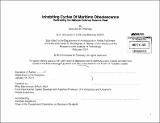Inhabiting cycles of maritime obsolescence : redirecting the National Defense Reserve Fleet
Author(s)
Polansky, Nicholas W. (Nicholas Wilkes)
DownloadFull printable version (24.16Mb)
Other Contributors
Massachusetts Institute of Technology. Department of Architecture.
Advisor
Miho Mazereeuw.
Terms of use
Metadata
Show full item recordAbstract
Defense is in a state of obsolescence. The metrics of risk have changed from threat of military invasion to that of weather. Infrastructure is in a state of transition. The Maritime Administration's National Defense Reserve Fleet (NDRF) has dwindled from 2,700 ships in 1946 to only 140 in 2013. Now, along with closure of over 350 military installations and their related infrastructures in the continental US, the 140 remaining sea-lift merchant vessels are deemed obsolete, no longer needed for global defense operations. This cycle of infrastructural obsolescence offers an opportunity to realign coastal sites of maritime service and production, within regional seaport operations, to mitigate the inevitable threat of a seismic and/or flood catastrophe while contributing valuable social utility through industrial ingenuity. Waterfront development must now be coupled with appropriate metrics of defense and redundancy, projecting a long term phasing for the future occupation of the post industrial estuary. This thesis proposes a strategic redevelopment of obsolete maritime infrastructures that programs a regional sea-lift defense program for the San Francisco Bay as a prototype for inland bay regions. It realigns one of three remaining sites of the NDRF to serve a region with a 63% chance of experiencing an earthquake with magnitude of 6.7 or greater in the next 30 years resulting in the loss of water, power, and shelter for 60,000 people in 27,000 buildings. The project proposes reprogramming the remaining NRDF merchant vessels as floating water, power, and food utilities and staging strategic coastal port infrastructures on an entirely ship powered waterfront, beyond the grid. These proposed hybrid landscapes work together as a strategic urban model for phasing resilient seaports in highly vulnerable coastal regions. They invert the "hard," land-borne conduits of power and water in favor of multiplied and thus redundant, "soft," distributed, waterborne infrastructure delivering power, water, and food to support emergency urbanism.
Description
Thesis: M. Arch., Massachusetts Institute of Technology, Department of Architecture, 2014. Cataloged from PDF version of thesis. Includes bibliographical references (pages 112-115).
Date issued
2014Department
Massachusetts Institute of Technology. Department of ArchitecturePublisher
Massachusetts Institute of Technology
Keywords
Architecture.